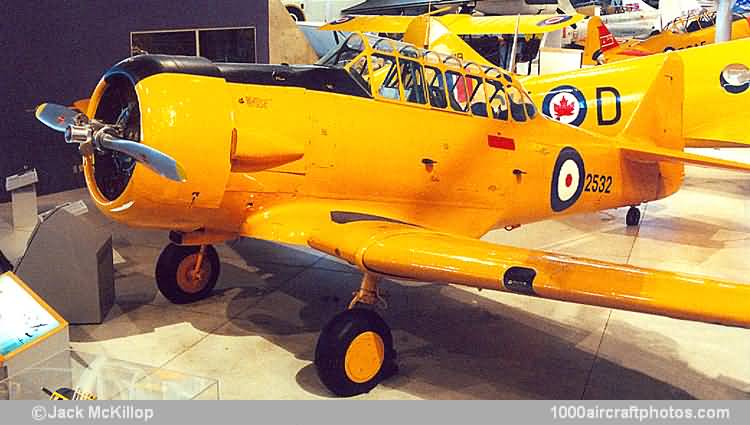03/31/2011. Remarks by Jack McKillop: "Britain began to rearm in the late 1930s but lacked advanced trainers and the British aircraft industry was not prepared to produce the quantity required. The RAF looked to the US for aircraft and found the North American NA-36 BC-1, a new kind of trainer with the equipment and attributes of operational combat aircraft. (The USAAC Type Symbol 'BC' indicated Basic Combat but this was dropped in 1940 in favor of 'AT' for Advanced Trainer.)
The BC-1 had a retractable landing gear, provision for armament, a two-way radio and navigation and engine instrumentation and in June 1938, the RAF ordered 200 aircraft based on the USAAC's BC-1. The order subsequently was increased to 400. These 400 aircraft bore the North American Model Number NA-49 and were named 'Harvard Mk.I' by the RAF. Canada was also rearming and in May 1939, the RCAF placed a separate order for 30 Harvard Mk.Is designated North American Model NA-61.
With the beginning of WW II, the RAF and British Commonwealth Air Forces had to expand rapidly requiring training aircraft and facilities. On December 17, 1939, an agreement was reached between Australia, Canada, New Zealand and the United Kingdom to establish the British Commonwealth Air Training Plan (BCATP), known in some countries as the Empire Air Training Scheme (EATS).
The agreement called for the training of nearly 50,000 aircrew each year, for as long as necessary: 22,000 aircrew from the United Kingdom, 13,000 from Canada, 11,000 from Australia and 3,300 from New Zealand. Under the agreement, air crews received elementary training in various Commonwealth countries before traveling to Canada for advanced courses.
Training costs were to be divided between the four governments. As a result, the BCATP/EATS was responsible for training nearly half the pilots, navigators, bomb aimers, air gunners, wireless operators and flight engineers who served with the RAF, RAAF, RCAF and RNZAF during the war.
To meet these training requirements, the RAF and RCAF ordered 600 North American Model NA-66 Harvard Mk.IIs, based on the USAAC's AT-6 Texan. Unlike the Mk.I, the Mk.II had blunt wing tips and triangular shaped fin and rudder and the fabric covered fuselage of the Mk.I was replaced by a metal covering. A number of these aircraft were sent to Canada, New Zealand and Southern Rhodesia. Later an additional 573 Mk.IIs were delivered to the RAF and RCAF.
Three other versions of Harvards were used by the RAF and Commonwealth Air Forces during WW II:
- Harvard Mk.IIA: There was fear during the war that there would not be enough strategic metals for the war effort and as a
result, North American built the AT-6C with low-alloy steel and plywood. A total of 1,056 Mk.IIAs were delivered to the RAF
under Lend-Lease.
- Harvard Mk.IIB: 2,485 aircraft equivalent to the AT-6A were built by Noorduyn Aviation Ltd. in Montreal, Quebec and
delivered to the RAF and RCAF between 1941 and 1945.
- Harvard Mk.III: When it was realized that there would not be a shortage of strategic metals, the production of standard
aircraft resumed. These were AT-6Ds with a 24-volt electrical system and 229 of these were delivered to the RAF under Lend
Lease.
The pictured aircraft was ordered by the RCAF and accepted on August 17, 1940. It served in several Canadian training schools until it was placed in storage in 1962 and transferred to the RCAF historic aircraft collection at Rockcliffe, Ontario in 1964."
